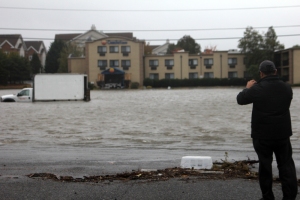
An onlooker is shown here taking photos of the flooding of a parking lot at the edge of the Hudson River in Edgewater, N.J. — Courtesy of S.P. Sullivan.
S.P. Sullivan, a 2010 graduate of the UMass Journalism program, has been reporting on Hurricane Sandy for NJ.com since the storm hit. He took time from his busy schedule to do a Q&A via e-mail:
Question: Tell me about your weekend. You were in Sunderland this past weekend and had to return to New Jersey. At what point did you realize you had to head back?
Sullivan: I was trying to have a relaxing weekend in Western Massachusetts, but I had been in on a conference call between government officials in the county I cover, their Office of Emergency Management staff and municipal officials, so even on the drive up Friday night I was already anxious about the storm. Sunday rolled around and I asked the weather guy at our sister paper, The Star-Ledger, when I should come back. He said things were going to get pretty bad pretty early Monday, and he was right.
Q: When did you start reporting? What were conditions like?
Sullivan: Friday, I guess. We knew something was coming, and I had written a story about a major investment a Boys & Girls Club that sits right on the Saddle River made in flood infrastructure for our Hurricane Irene anniversary package, so on Friday I followed up with them to see how they were prepping for the storm. Then I took part in that conference call with the county and wrote a story about country-wide preparations, recording it off my iPhone and embedding an MP3 for anyone interested in hearing how their elected officials were handling things.
I oversee two other reporters in the county, and they each work a weekend shift, so they covered Saturday and early Sunday. I even went on a hike Sunday afternoon.
By Sunday evening, my girlfriend Rosie and I were making a mad dash back to Jersey, and the county was holding another conference call, so I came up with an elaborate scheme where I piped my iPhone into my audio recorder using one stereo cable (the kind you use to listen to your iPod in the car), and then piping the recorder into the car’s audio system using another. That way, I was able to listen to the call through my car stereo as I drove, and then was able to again embed the call in the story I wrote Sunday night after we got back.
Q: Were you filing text/video and images?
Sullivan: We were filing text fast and furious. Each county had its own live blog starting early Monday morning, and I was
in charge of the blog for Bergen County, though each of us in the county took shifts maintaining it. That page served as a clearing house for all storm-related coverage in the county, providing time-stamped links to our stories as we filed them, as well as mini-updates from various agencies and photos and stories we were getting from our users via e-mail and social media.
I did manage to get out on Monday afternoon to capture the swelling of the Hudson River (I live in the Palisade Cliffs, overlooking the Hudson), and did a quick story from there. Things were moving so fast that the focus was more on photo than video, so I actually didn’t shoot any video during the storm. It was lots of quick updates and lots of photos.
Q: What role did social media play in your reporting?
Sullivan: Major events like this storm or the tornado in Springfield in 2011 really bring out the value in social media as a tool for journalism. I was able to post quick updates and photos from the field on my Twitter account, which the other staff could then cull for use in our live blog, and on Tuesday, when everybody, myself included, lost power, one of my reporters went to one of the hardest-hit areas and was able to get photos up on Twitter. Internet service was almost non-existent, so he was phoning in dictation to me and I was pulling photos from his Twitter feed for use in his stories.
Then of course there was the instant feedback from people in our communities: We got information on school closures, photos and updates on power outages in parts of the county we weren’t able to get to , all from our Facebook and Twitter accounts, which we maintained throughout the storm. Our live blog became a mini social network of its own, too, with a lot of useful information from readers posted in the comments or emailed to the address we posted on the page.
Q: What’s the experience been like overall?
Sullivan: Taxing. The three of us cover the most densely-populated county in the state, with almost a million residents, so keeping up with the live blog and getting out into the field as much as possible is daunting. Monday night into Tuesday morning was tough, because the majority of our staff lost power, so we were running on battery life and mifi cards. We escaped the worst of it in North Jersey, and many of our reporters in South Jersey couldn’t get online Tuesday morning, so I was even helping out with coverage of the devastation in Atlantic City from my outpost up north.
It was also a lot more challenging to physically cover the storm than it was to cover the Springfield tornado, because the tornado came and was gone in a matter of minutes, whereas the storm was stretched over days. Springfield is also a lot more compact, so getting around Bergen, which has a lot of major highways which were closed or washed-out, was difficult. So it’s been frustrating not getting out into the thick of it as much, but staying glued to a computer trying to get people the most recent updates and important information is a service in of itself. Live storm and election coverage have kind of become specialties of mine, so it’s gonna be a busy week.







